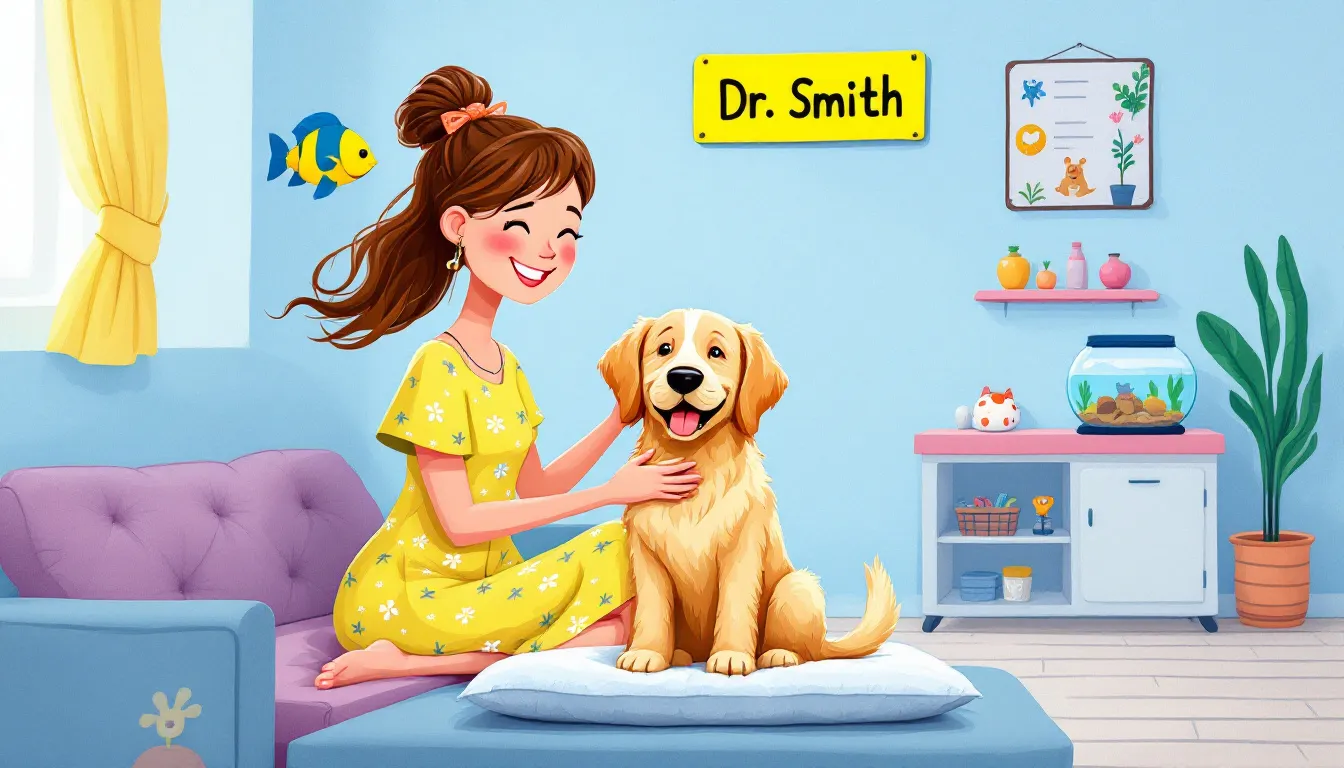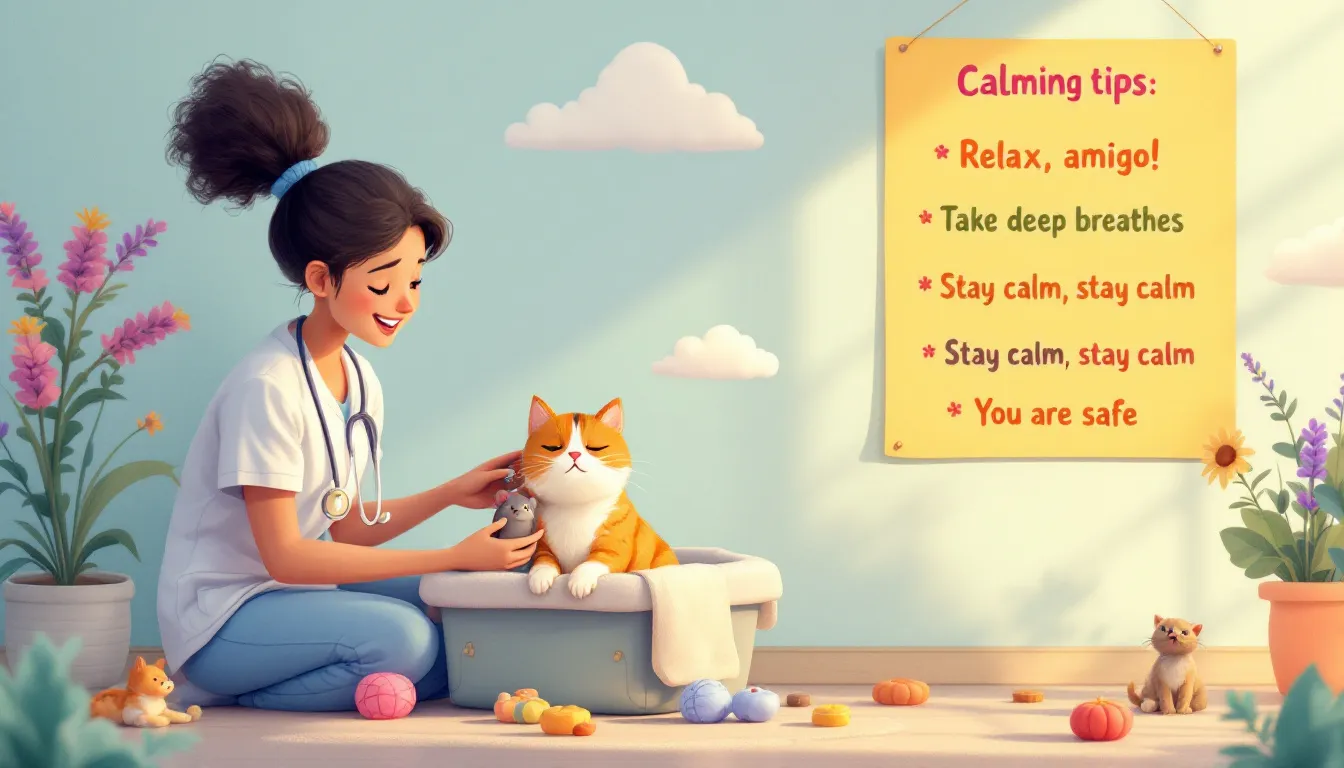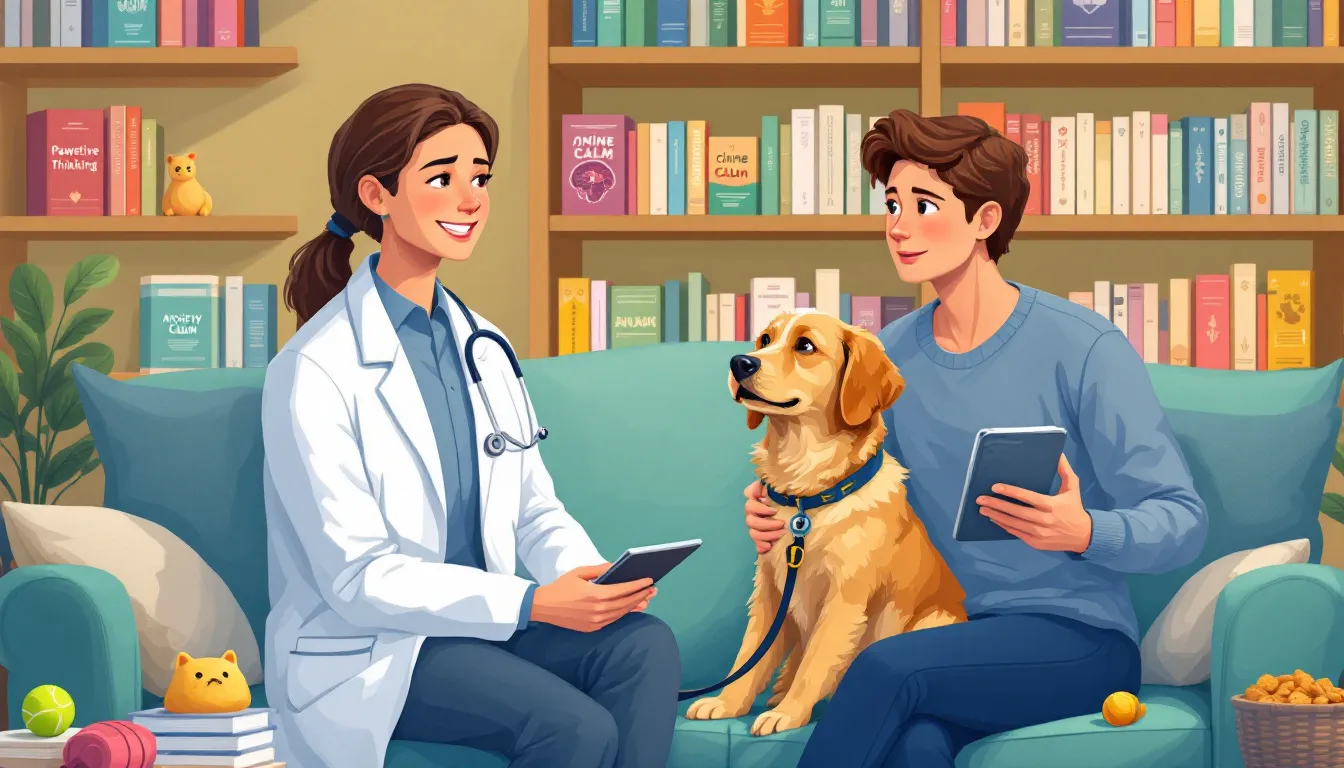Vet visits often cause stress and anxiety for pets, but there are steps you can take to make them more comfortable. In this guide on preparing your pet for vet visits how to reduce stress anxiety, we’ll discuss tips like getting them used to handling, creating positive car ride experiences, and practicing ‘happy visits.’ These methods aim to make vet visits more relaxed and stress-free for your pet.
Key Takeaways
-
Familiarizing pets with handling through desensitization techniques can significantly reduce anxiety during veterinary visits.
-
Selecting the appropriate carrier or leash and creating a comfortable environment during travel are crucial for minimizing pet stress during vet visits.
-
Practicing positive experiences, such as Happy Visits to the clinic, and staying calm as an owner can help establish a stress-free environment for pets during veterinary appointments.
Get Your Pet Comfortable with Handling

Getting your pet comfortable with handling is a crucial step towards a stress-free veterinary visit. Many pets, especially adult dogs and young kittens, may resist and feel stressed when touched in certain areas during a vet visit. Regularly touching your pet’s ears, paws, and mouth at home helps them become more accustomed to contact in these sensitive body parts. Animals can also benefit from this kind of handling.
Start by gently touching and manipulating these areas in short, pleasant sessions. Offer your pet praise and treats for their cooperation. This helps build positive associations with handling and reduces anxiety during veterinary visits. Gradually increase the duration of these sessions as your pet becomes more comfortable. The aim is to desensitize your pet to handling, reducing resistance and promoting relaxation during vet visits.
Start by listing some forbidden forms of the keyword “practice handling” according to the rule 5. Then, find out if there’s a chance to incorporate the keyword without making any extra assumptions, according to the rule 2. Keep it short.
Simulate a vet exam by gently restraining your pet and practice handling sensitive areas, rewarding them throughout the process. This familiarizes your pet with the types of handling they will experience, reducing anxiety and making the dog’s vet visit less stressful for the animal.
Remember, patience is key. Each pet is unique, and what works for one may not work for another. Take your time, be consistent, and always use positive reinforcement to help your pet feel more comfortable with handling and less anxious during vet visits.
Choose the Right Carrier or Leash
Selecting the appropriate carrier or leash is crucial for a stress-free veterinary visit. For cats, a hard carrier with multiple entry points and a removable top works best. This type of carrier provides security during transport and allows for easy access and examinations at the vet clinic. Good ventilation in the carrier is also important for your pet’s comfort during travel.
Keep the carrier accessible at home to help your cat feel comfortable with it. Add cozy blankets and toys, and place treats inside to create positive associations. Ensure your cat feels safe and secure in the carrier before using it for vet visits. A soft blanket can help make the carrier more inviting for your cat. Soft carriers may not be suitable for nervous cats as they can collapse easily, making handling difficult.
For dogs, using a shorter leash that is locked to allow minimal slack can provide better control during vet visits. When transporting smaller dogs, a comfortable, familiar carrier that is covered can help reduce their anxiety. Making sure your pet feels secure during transport can significantly reduce stress levels and make the vet visit more pleasant.
Positive Car Ride Experiences
Positive car ride experiences are essential for a stress-free veterinary visit. Many pets associate car rides with stress, but you can change this by building positive associations. Begin with short, pleasant trips and reward your pet with treats and praise during the ride. This approach helps create positive associations with car rides and reduces anxiety.
Offer treats during the ride and take short trips to enjoyable places to acclimate your dog to car rides. Gradually increase the duration of these trips to build your pet’s comfort level. For cats, providing water and allowing breaks for rest during travel is crucial to keep them hydrated and comfortable.
Calming classical music can also help ease a cat’s anxiety during travel. Pheromone sprays in the carrier or car can help reduce your pet’s stress levels during rides. Short, positive car trips can acclimate your cat to traveling, reducing motion sickness and making vet visits less daunting. Additionally, you can play calming music to further soothe your cat during these experiences.
By creating a positive experience during car rides, you can greatly reduce your pet’s anxiety and make the veterinary visit an overwhelming experience in the back seat more pleasant.
Practice Happy Visits to the Vet Clinic

Happy Visits to the vet clinic familiarize your pet with the unfamiliar surroundings without the stress of an actual appointment. These visits create positive experiences for pets, building positive associations with the vet’s office and the veterinary hospital. These visits can strengthen the emotional connection between pets and the veterinary environment, making future visits less stressful.
Bring your pet’s favorite treats and toys to enhance the experience during a Happy Visit. For cats, bringing a favorite blanket or towel can provide comfort during the appointment. These familiar items help reduce anxiety and make your pet feel more at ease in the vet clinic, along with some tasty treats.
Young kittens and many dogs particularly benefit from Happy Visits as they help them get accustomed to the sights, unfamiliar sounds, and smells of the clinic. However, they may not be suitable for pets displaying moderate to high levels of fear or anxiety during visits. In such cases, it is best to consult your veterinarian for additional strategies to reduce stress.
By regularly practicing Happy Visits, you can help your pet feel more comfortable and relaxed during veterinary visits. This approach not only reduces stress but also makes the experience more enjoyable for both you and your pet.
Prepare for the Day of the Visit

Proper preparation on the day of the vet visit ensures a stress-free experience. Avoid large meals for your cat before the visit to prevent nausea. Classical music can help keep pets calm during the journey and vet visit. A soothing voice from the owner can also help calm a cat during the visit.
Add comfy bedding, familiar scents, treats, and a favorite toy in the carrier for your pet’s comfort. Bring your dog’s favorite treats, small soft treats, and a rubber treat dispenser to help keep your pet calm. These items help create positive associations with the vet clinic and reduce anxiety.
Using a Thundershirt® can help reduce anxiety by swaddling the cat, providing a calming effect. It is recommended to bring small, soft treats to the veterinary appointment. These treats can be easily broken into smaller pieces. Preparing for the visit can ensure your pet remains calm and comfortable, making it less stressful.
Stay Calm and Supportive

Your demeanor as a pet owner significantly affects your pet’s stress levels during a veterinary visit. Remain calm and behave normally, as pets can sense their owner’s emotions and may feel anxious if the owner is worried in a stressful environment. Creating a comfortable environment at the clinic helps reduce fear and stress in pets. Pet owners should be mindful of their calm behavior to ensure a positive experience for their pets and support their pet’s health, especially in relation to a dog’s stress.
Use calming music and pheromones in the clinic to soothe anxious pets. Offering treats and toys fosters good feelings during the vet visit. Cuddles also help create positive associations. Inform the veterinary team of your pet’s handling preferences and sensitivities upon arrival. This information helps the veterinary team provide better care and reduce your pet’s anxiety.
Minimize your dog’s anxiety in the waiting room by waiting in a quieter area, like outside or in the car. Staying calm and supportive helps your pet feel more secure and reduces their stress levels during the visit.
Consult Your Veterinarian About Anti-Anxiety Options

Consult your veterinarian about anti-anxiety options if your pet continues to experience anxiety. Veterinarians can recommend both long-term and short-term anti-anxiety medications tailored to your pet’s needs. Long-term medications may take several weeks to show effects and require daily administration, whereas short-term medications can provide immediate relief for stressful situations.
Consider non-drug products such as calming supplements, compression garments, and pheromones to help reduce anxiety. These products can be effective in managing your pet’s stress levels during veterinary visits. Ask your veterinarian for advice on the best options for your pet’s health and well-being.
Consulting your veterinarian about anti-anxiety options helps you find the best solution to keep your pet calm and comfortable during visits.
Summary
Preparing your pet for a stress-free veterinary visit involves a combination of handling exercises, choosing the right carrier or leash, creating positive car ride experiences, practicing Happy Visits, and staying calm and supportive. Additionally, consulting your veterinarian about anti-anxiety options can provide further relief. By implementing these strategies, you can ensure a more pleasant and stress-free experience for both you and your pet during veterinary visits.
Frequently Asked Questions
How can I get my pet comfortable with handling?
To ensure your pet becomes comfortable with handling, consistently practice handling their ears, paws, and mouth while rewarding them with treats and praise to create positive associations. This approach fosters trust and familiarity over time.
What type of carrier is best for my cat during vet visits?
A hard carrier with multiple entry points and a removable top is the best option for your cat during vet visits, as it provides ease of access and comfort for your pet.
How can I create positive car ride experiences for my pet?
To create positive car ride experiences for your pet, begin with short trips, rewarding them with treats and praise to establish favorable associations with traveling. This approach will help ensure your pet enjoys future car rides.
What are Happy Visits, and how can they help my pet?
Happy Visits are non-medical trips to the veterinary clinic designed to create positive experiences for your pet, fostering good associations with the veterinary environment. They can help reduce anxiety and fear during future visits, ultimately benefiting your pet's overall health and well-being.
What anti-anxiety options are available for my pet?
It is advisable to consult your veterinarian regarding both long-term and short-term anti-anxiety medications, as well as non-drug options such as calming supplements, compression garments, and pheromones. These options can effectively address your pet's anxiety issues.


